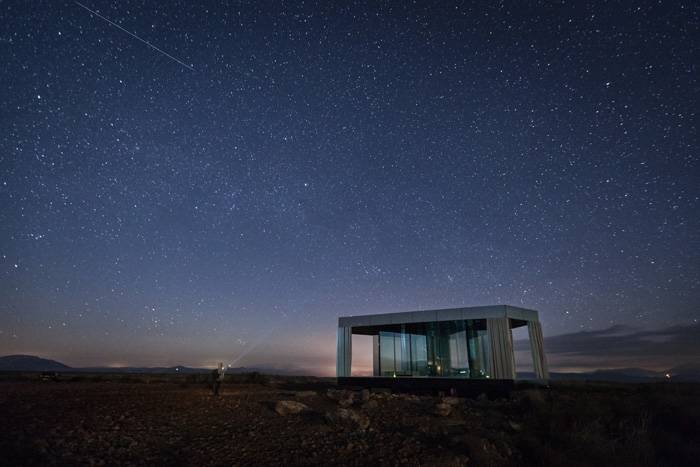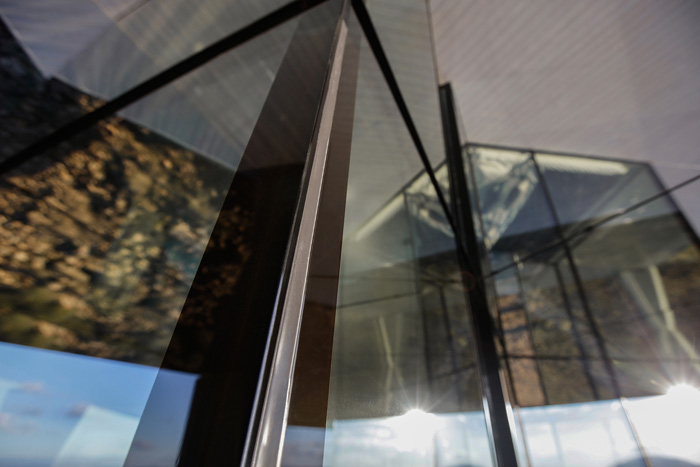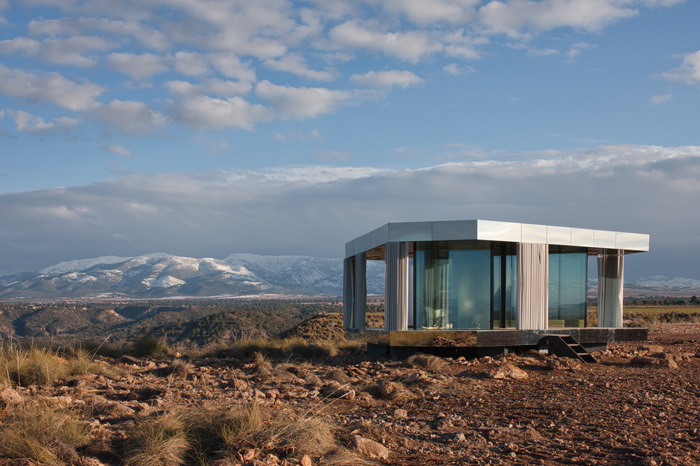Guardian Glass can be found in some of the world’s most iconic buildings. The global manufacturer recently launched a new web tool to help architects better understand the aesthetic and functional possibilities of this beautiful material. Greg Corke reports
La Casa del Desierto, ‘the Desert House’, located in the wilderness of Spain’s Gorafe Desert, was the perfect project for high-performance glass manufacturer Guardian Glass to demonstrate just how far glass has come as a material. With daytime temperatures soaring to 50°C in summer and dropping as low as -10°C in Winter, keeping this off-the-grid glass-clad property comfortable for human occupation was a massive challenge.
The project was led by Spela Videcnik of OFIS Architects in Slovenia with support from specialists from Guardian Glass and engineers and energy consultants from AKT II and Transsolar. Speaking at the recent Guardian Glass press event in London, Videcnik explained how the use of high-performance glass on the curtain wall façade meant the building was able to perform even in the height of summer.
“The triple glazing has different coatings that don’t allow sun [one part of heat from the sun] to enter inside the building, meaning that the interior doesn’t get heated. Basically, what we calculated was that when outside is 50°C, if you use no air conditioning the interior space through the whole day is 28°C, which I think for me is amazing,” she said.
Thermal performance was obviously essential because of the harsh environment but not at the expense of aesthetics. Videcnik wanted occupants to have a clear view of the beautiful surroundings and plenty of natural light indoors by keeping the glass as transparent as possible.
“We always create windows as large glass walls, even in low budget projects, because we believe it is important that the home has no border between interior and the nature, have lots of sun and light and that this border is invisible,” she said.
Striking a balance
Guardian Glass is one of the world’s largest manufacturers of high-performance glass. Its products are used on many high-profile projects from One Blackfriars in London to the Burj Khalifa in Dubai, as well as in homes, offices and cars.
The company is well known for the performance of its products but, in recent years has also started focussing more on visual appearance. “Aesthetics is very important for architects and for buildings in general,” says Sheldon Davis, Vice President of Science, Technology & Innovation at Guardian Glass. “It is the thing that enables the message, the brand, the beauty that we all enjoy in these buildings.”
Guardian Glass reports that architects are now demanding glass with more neutrality, so the glass appears to be very clear, rather than blue or green, especially when viewed from an angle. However, there’s always a trade-off for a crystal-clear appearance. Aesthetics, performance and function are intrinsically linked.
For example, the amount of light glass lets in has to be balanced against the amount of heat it lets in. This is measured by selectivity, the ratio between light transmission and solar factor (the percentage of solar radiant heat energy that is transmitted through glass – also referred to as Solar Gain or the G value). Thermal performance – keeping heat inside the building – is also important, particularly in winter, as is acoustic performance.
Ian Simpson, founding partner at SimpsonHaugh the architect on London’s One Blackfriars spoke at the Guardian Glass event about the choice of glass on the high-profile residential building which features a double-skin façade.
“We didn’t want it to look green, so we worked hard to ensure we could afford a low iron glass and we went through a process of assessing different coatings to balance the G-value performance with the visual clarity of the glass.”
Reflectivity also plays a very important role in aesthetics and architects may choose a glass that is highly reflective, perhaps for privacy or to emphasise an adjacent building, or one with as little reflection as possible, as Davis explains, “Glass has this beautiful transparency but under certain lighting conditions, of course, you’ll see a reflection and that reflection will get in the way of what you’re trying to look at and this can be bad, whether that’s in museums or shops, you want to see through the glass.”
On One Blackfriars, finding the right level of reflectivity was a critical part of the design as SimpsonHaugh wanted to ensure the building would be identifiable as a residential building and not as a commercial high-rise.
“We’re not perverse enough to make it so reflective that you can’t see the life going on inside because I think that’s quite an interesting richness, a layering to the building,” explains Simpson. “From a distance it has a strong expression. As you get closer and closer you start to read the individual within it.”

Demystifying glass
Determining the design objectives for aesthetics, performance and function is one thing but Identifying a glass solution to fit those requirements is another. Historically this has been left to specialists – façade engineers, cladding specialists or glass unit makers but Guardian Glass is now looking to give others on the project, especially architects who drive the vision of the building, the ability to understand and specify glass products to help make better informed decisions early on in the design process.
“It’s our responsibility to support the architects in glass specification,” says Liam Williamson, Guardian Glass. “Because you don’t want them designing these beautiful buildings, selling it to their client, and then six months down the line we tell them it’s absolutely impossible to make [to do in glass].”
Last month Guardian Glass released ‘Glass Analytics’, a range of free, easy-to-use online tools to help architects – and specialists alike – choose the appropriate glass solution to match the design objectives of a project.
“The key thing for us is that we try to demystify some of the tools that are typically used by specialists and we put them on the web and make them available to our customers, so they can use the tools themselves and basically make it easier to specify the right glass in the right applications,” says Guus Boekhoudt, VP Guardian Glass.
“Glass Analytics provides facade solutions that allow architects, designers, cladders and glass processors to explore aesthetic and functional possibilities while meeting complex energy, daylighting and acoustic requirements,” explains Dimosthenis Liouris, Technical Advisory Centre Manager for Guardian Glass in Europe.
The tools are easy to use. Simply choose the glass type, doubled glazed or triple glazed, together with coatings and specified gaps and the system will provide all the performance figures that go with that – such as visible light transmission, solar transmission, visible reflectance (inside and outside), solar reflection outside, solar factor, etc. These figures can be exported in a PDF report, which an architect could pop straight into a specification document, or to Excel for use in third-party simulation tools or to do comparisons between products.
Glass Analytics also includes a simple Glass Visualiser that allows users to evaluate aesthetic properties. Simply choose the glass you want, select a building and perspective, and see how various sky conditions affect its appearance.
“You can play around with the internal lighting to see what that would do to it as well,” adds Williamson. “Because that plays a huge role in the aesthetics of the glass, especially in something like store fronts.”
In addition to raw data, Glass Analytics allows users to export BIM objects of detailed insulating glazing units based on the custom make-ups created. For Revit, this can be a glass IG curtainwall panel, or a window based generic model. For other BIM tools, there’s IFC format.
Guardian Glass BIM objects are arguably more suited to high profile projects where the architect may specify glazing units with minimal framing. When it comes to unit makers, who put Guardian Glass in aluminium or PVC frames, the onus would be on the manufacturer to provide the BIM object. With all the different types and framing options this could run into hundreds which can soon become unwieldy.
Guardian Glass acknowledges that some of those using its ‘Glass Analytics’ tool will be completely new to glass and will need a little more hand holding, so there are plans to give these users a gentle introduction to the technology on offer.
“We have a new tool that’s being launched this summer. We’re re-launching our products page, which will have a bit of a Wizard, so users could say ‘I’m looking for a 70 light transmission glass that looks blue that is in this range.’ And it will say, ‘These are your options’ and it will also give examples of where that product has been used in the past,” explained Williamson.
The crazy greenhouse
When the mayor of Gorafe first heard about La Casa del Desierto he thought it was crazy to build something which was essentially a greenhouse in a desert, especially when all traditional houses in the area were cave houses, buried into the landscape to keep the interiors cool.
The Desert House was borne out of Spela Videcnik’s strong desire to merge the interiors of her buildings with nature. She’s no glass specialist by her own admission but the building would not have been conceived without her solid understanding of what can be achieved with modern high-performance glass.
Of course, while Videcnik had a specialist team to guide her; other architects may not. However, giving them the tools with which to explore the aesthetic and functional possibilities of glass early on in the design process can only be good for architecture.





If you enjoyed this article, subscribe to AEC Magazine for FREE






